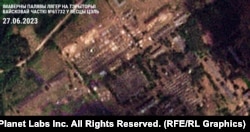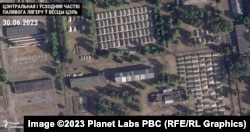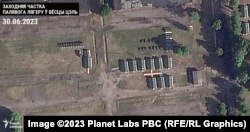Nestled along a serpentine river and surrounded by a sea of leafy birch trees about 90 kilometers southeast of Minsk, the Belarusian village of Tsel seems like an idyllic place to hide from the noise and congestion of city life.
In recent years, residents of Minsk and the district seat, Asipovichy, have snapped up homes in Tsel to use as weekend getaways.
That may soon change.
Rumors have been swirling locally that Belarus is reviving the nearby abandoned military garrison in Tsel. Some residents worry that in the wake of a startling but short-lived mutiny that shook Russia, it could be used to settle fighters from the mercenary group Wagner who have been handed an offer to move to Belarus.
Now satellite images provided by Planet Labs confirm that something very substantial is going on at Tsel. A comparison of images taken on June 17 and June 30 shows the appearance of hundreds of rectangular objects that seem to be field tents. There are also signs of construction work, such as excavated pits. However, there is no military equipment, such as trucks or weapons, visible in the images.
Local residents told RFE/RL that workers from communal services, water supply, and other agencies have arrived at the abandoned garrison to refurbish it.
The rectangular objects in the images measure 12 meters by 8 meters and are identical to those found at Belarusian bases where Russian mobilized personnel have been training.
Tents of such size can accommodate from 20 to 50 individuals each. RFE/RL counted 303 of the objects, implying as many as 15,000 troops could be settled in Tsel.
Oleh Zhdanov, a Ukrainian military expert who examined the satellite images, told RFE/RL he did not think the site was being refurbished for Wagner members given how it has been just a few days since the mutiny and the murky deal that ended it.
"Very little time has passed to start building a camp specifically for the Wagner group. This is unrealistic," Zhdanov said.
Prigozhin, who had harshly criticized the Russian military leadership for months, announced on June 23 that his forces would make a "march of justice" into Russia from Ukraine, where they played a key role and suffered severe casualties in heavy fighting for the Donetsk region city of Bakhmut.
Wagner mercenaries essentially took control of the large southern city of Rostov-on-Don, and a separate contingent headed toward Moscow on a highway. President Vladimir Putin denounced what he called an "armed mutiny" and said the organizers were traitors who would be held responsible.
Late on June 24, Prigozhin abruptly called off the advance, saying that his force was about 200 kilometers from Moscow but that he wanted to avoid bloodshed.
The Kremlin and Belarusian ruler Alyaksandr Luksahenka claimed they had struck a deal under which Wagner mercenaries would avoid prosecution and Prigozhin would move to Belarus. On June 26, Putin said Wagner fighters could join the Russian military, go back home, or go to Belarus.
The details of the purported agreement have not been made public. The Washington-based Institute for the Study of War (ISW) said on June 28 that it appeared that the three sides were still negotiating the terms of the deal.
On June 27, Lukashenka claimed that Prigozhin had arrived in Minsk as part of the agreement. Flight data showed a private jet belonging to Prigozhin landed in Minsk that day but returned to St. Petersburg, where the Wagner leader has normally been based, on June 28.
There has been no confirmed sighting of Prigozhin since he was photographed leaving Rostov-on-Don in the back seat of a white SUV late on June 24. He has not commented on his whereabouts since then, and there have been no firm indications that any Wagner fighters have gone to Belarus.
Lukashenka expressed interest in having Wagner fighters -- who in some cases are more experienced and have fought in Ukraine more effectively than regular Russian forces -- settle in Belarus and train its troops.
"We are not building a camp for them for now. If they want [to settle here], we will find a place for them. We have offered them one of our abandoned garrisons," he said on June 27, without mentioning a specific location.
Lukashenka's wording could potentially describe the site at Tsel -- but the refurbishment there began in early June, weeks before Prigozhin's mutiny.
Zhdanov said the apparent construction there could be for Russian soldiers who are not from Wagner and might undergo training in Belarus, as others have since Russia's February 2022 invasion of Ukraine -- one of the ways that Lukashenka has supported Moscow's war without openly sending Belarusian troops to fight in it.
Many of the Russian soldiers who have trained in Belarus were called up in a massive mobilization decreed by Putin in September 2022. While the Kremlin claimed it fulfilled its target of up to 300,00 men within weeks of the announcement, the Russian Defense Ministry has continued to draft people amid a manpower shortage.
Some experts have forecast that Russia could announce a second round of large-scale mobilization as it suffers heavy casualties and Ukraine pushes forward with the counteroffensive it launched in early June.
Zhdanov noted that Tsel is just 30 kilometers from a base in Asipovichy where Russian soldiers are training for eventual deployment to Ukraine.
He also brought up a political element that may be at work, saying that public statements notwithstanding, he doubted that the Kremlin would be happy to have Lukashenka -- whose ties with Putin and Moscow are tight but tense --hosting forces that tried to topple Russia's military leadership.
Another factor: signs that the Russian state is seeking to gain control over Wagner forces abroad.
George Barros, a military analyst at the Institute for the Study of War, told RFE/RL that Belarus has plenty of available space at other bases scattered around the country and could be used to settle Wagner fighters.
"There's no reason why those field facilities cannot house Wagner guys," he said.
He noted that Russia had at its peak as many as 30,000 troops in Belarus in late 2021 and early 2022 prior to the invasion of Ukraine. Barros said Russia may have just 1,000 troops in Belarus at the moment.
Barros did not exclude that the construction at Tsel could be a "red herring" to distract attention from other developments in Belarus, namely the construction of the hardened facilities where the tactical nuclear weapons will be placed.
Putin and Lukashenka have said they agreed on the transfer of tactical nuclear weapons from Russia to Belarus and that the first batch has already been delivered.
Russian authorities have said that Moscow would retain control of the weapons and potentially deploy troops to Belarus to maintain and oversee them. It is unclear how many personnel Russia might transfer to Belarus for this purpose.
Tsel had most recently been home to a missile brigade, earning it a reputation as "the cradle of the Belarusian missile forces."
At its peak in the 1990s, Tsel hosted 1,500 service members, including personnel relocated from former Warsaw Pact countries following the fall of the Berlin Wall and the collapse of communism in Eastern Europe in 1989.
Over the years, as the Belarusian armed forces contracted after the Soviet collapse and the end of the Cold War, the number of military personnel in Tsel dropped to about 200.
In 2018, the remaining soldiers were transferred to another base closer to Asipovichy and the barracks abandoned.
On June 27, Vyorstka, an independent Russian-language media outlet, reported that Belarus was building several camps for a total of up to 8,000 Wagner fighters and that some could be settled near Asipovichy.
Wagner's ranks include many Russian convicts who were promised freedom in exchange for six months of service in the war. Several of the former prisoners have committed violent crimes after returning from Ukraine.
The silence about what is going on in Tsel has locals on edge.
"Where there's smoke, there's fire. We are preparing for the worst," a resident whose name was not given told Belarusian news outlet Nasha Niva.














